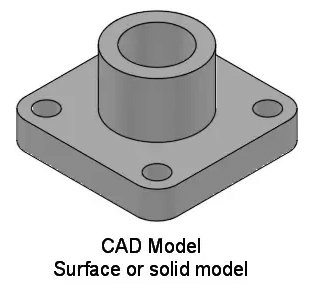Mechanical Engineering Exam > Mechanical Engineering Notes > Manufacturing Engineering > Geometric Modeling
Geometric Modeling | Manufacturing Engineering - Mechanical Engineering PDF Download
Solid Modeling
Also known as volume modeling, this is the most widely used method as it provides a complete description of solid modeling. Solid modeling defines an object by its nodes, edges, and surfaces; therefore, it gives a perfect and explicit mathematical representation of a precisely enclosed and filled volume. Solid modeling requires the use of topology rules to guarantee that all surfaces are stitched together correctly. This geometry modeling procedure is based upon the “Half-Space” concept.

There are two prevalent ways for representing solid models:
- Constructive solid geometry: Constructive solid geometry is a combination of primary solid objects (prism, cylinder, cone, sphere, etc.). These shapes are either added or deleted to form the final solid shape.
- Boundary representation: In boundary representation, an object’s definition is determined by their spatial boundaries. It describes the points, edges, surfaces of a volume, and issues command to rotate, sweep a binds facets into a third dimensional solid. The union of these surfaces enables the formation of a surface that explicitly encloses a volume.
Solid Modeling is the most widely used geometric modeling in three dimensions, and it serves the following purpose:
- Solid modeling supports weight or volume calculation, centroids, moments of inertia calculation, stress analysis, heat conduction calculations, dynamic analysis, system dynamics analysis.
- Solid modeling supports the generation of codes, robotic and assembly simulation
- Solid modeling stores both geometric and topological information; can verify if the two objects occupy same space
- Solid modeling improves the quality of design, enhances visualization, and has the potential for functional automation and integration.
Different solid modeling techniques are as follows:
- Constructive Solid Geometry
- Boundary Representation
- Feature-based modeling
- Primitive Instancing
- Cell decomposition, spatial enumeration, octree
Surface Modeling
Surface modeling represents the solid appearing object. Although it is a complicated method of representation than wireframe modeling, it is not as refined as solid modeling. Although surface models and solid models look identical, the former cannot be sliced open the way solid models can be. This model makes use of B-splines and Bezier for controlling curves.

A typical surface modeling process involves the following steps:
- Generation of a model combining the three-dimensional surfaces and solids
- Conversion of the model to surfaces, taking advantage of associative modeling
- Validation of imperfections with surface analysis tools
- Reconstructing surfaces of objects to apply smoothness to the object
Surface modeling is used to:
- To shape design and representation of complicated objects such as a car, ship, and airplane bodies as well as castings
- There are situations where models imported from another CAD system usually lack details of the features it is comprised of. If the surfaces are complex, applying changes to this type of geometry can be quite the task. In such cases, surface modeling techniques can be used to one or more faces of the model to make the desired changes.
- Surface modeling enables building one face at a time so that one can control the exact contour and direction of any face. This feature comes in handy at a time when solid modeling technique fails to create the complex shape of a feature as it builds up several sides of shape at once.
- As it is not limited to the direct construction of a model face, surfaces can also be used as a reference geometry in a transitional step towards the creation of the required model face.
- Now, there is another modeling technique which requires a combination of solid and surface modeling techniques to create a solid model. This technique generally involves starting the model as a solid and using surfaces to modify it. Or, changing the solid to surfaces to shape and contour it, then turning it back to a solid when done.
Wireframe Modeling
- The wireframe model is perhaps one of the earliest ways of representing a solid model. It consists of vertices and lines and is a skeletal representation of a real-world 3D object. It was developed back in the 1960s; it is also referred to as “Stick figure” or “edge representation.”

- The lines within a wireframe connect to create polygons, such as triangles and rectangles, that represent three-dimensional shapes when bound together. The outcome may range from a cube to a complex three-dimensional scene with people and objects. The number of polygons within a model is a good indicator of how detailed the wireframe 3D model is.
- Wireframe modeling helps in matching a 3D drawing model to its reference. It allows the creator to match the vertex points, so they are in alignment with the desired reference and see the reference through the model as well. Although Wireframe modeling is a quick and easy way to demonstrate concepts, creating a fully detailed, precisely constructed model for an idea can be extremely time-consuming, and if it does not match what was visualized for the project, all that time and effort was wasted. In wireframe modeling, one can skip the detailed work and present a very skeletal framework that is simple to create and is apprehensible to others.
The document Geometric Modeling | Manufacturing Engineering - Mechanical Engineering is a part of the Mechanical Engineering Course Manufacturing Engineering.
All you need of Mechanical Engineering at this link: Mechanical Engineering
|
52 videos|54 docs|29 tests
|
Related Searches























